Outdoor lighting facilities improve visibility and safety in public / remote areas, reduce the risk of SGBV, and lower the incidence of crime and vandalism, improving the lives of refugees. They also enable more community gatherings and social activities. Providing sufficient levels of light throughout a refugee settlement is expensive and requires careful planning.
A Two-Tiered Approach to Community Lighting in Refugee Contexts
A two-tiered approach to community lighting uses two conventional methods; one to produce security lighting and the other to produce high intensity light for social, educational, livelihoods, and other community-based activities – both of which are common place in developed cities.
Through the use of low intensity lights on transport routes, security and safety can be enhanced without promoting the unnecessary gathering of community groups. This can reduce the risk of protection related to the gathering of groups at night but can also help avoid potential traffic-related accidents that can be linked to newly installed junction lighting.
High intensity lights can be located in communal areas and other areas where community gathering can be promoted. Through creatively selecting where high and low intensity lights are located within a settlement, there is the potential to influence the population dynamic at night. This enhances safety and security and revitalises a community’s feelings of wellbeing during evening activities.
Think about where you have seen different lighting arrangements when walking or driving at night, playing sport, or shopping.
The simplest two-tiered approach can be done in two ways. The first is to purchase two different solar lights, each producing a different intensity and spread of light. The second is to purchase lights with the same intensity and mount them at different heights above the ground or install different lenses in front of the bulb (diffuse/concentrated beam). Generally speaking, lights are quoted as producing a certain number of lumens – the total amount of light emitted from bulbs – not the amount of usable light over a particular area on the ground. The intensity of light decreases as the distance from a light source increases, but increases the illuminated area. This phenomenon can be used to create different lighting solutions (high intensity/small areas and low intensity/large areas) from the same light by changing its mounting height.
Security Light
A light mounted high from the ground will produce low intensity lighting at the ground level that will be spread over a large area. The light intensity available should be able to remove shadows and illuminate potential hazards, making this fit for security purposes. Security lights are not intended to provide enough light to support educational activities such as reading, or illuminate market stalls.
Communal Light
A light mounted relatively close to the ground (compared to the security light) will produce a higher intensity, more concentrated beam of light, ideal for illuminating small areas that can be used for education and livelihood activities.
If lights are produced with a movable coupling, the height of different lights can be adjusted as and when differing needs dictate. In addition to changing the height of lights, it is possible to change the lens of the light. Such modifications can be done easily with community-based consultation.
Lenses can also be used to add colored filters or to alter the way in which light is spread or concentrated. Some common examples of these types of adaptations are: anti-social behavior lighting around underpasses in urban areas, UV lighting to deter public drug use, lighting variations on public heritage buildings to create a sense of harmony and impression, brightly colored light to attract insects away from designated areas, and warning lights as danger/hazard signaling.
Street lights for effective communication and awareness raising
Communities are often drawn to well-lit areas at night and groups are often seen gathering under streetlights when they are available. This creates a unique opportunity for effective information sharing with the refugee population through communication mediums such as message boards.
Message boards will be located in strategic locations within the targeted settlements. Once installed, they will be used to engage the refugee community in regular two-way communications with UNHCR and implementing partners, and UNHCR, implementing partners and facilitate communication within the community. Notice boards could also facilitate communication within the refugee community itself.
The message boards could take many forms such as:
– Pin boards;
– Chalk boards, which could then double as a teaching aid as long as chalk could be supplied or was readily available;
– A combination of the two.
This highlights the need for an improved awareness around the potential in lighting interventions and a need to improve planning processes around how they are implemented.
If you’d like to repost this article on your website, please see our reposting policy.

